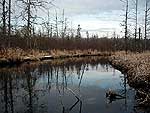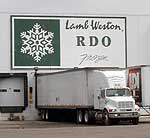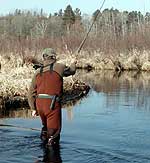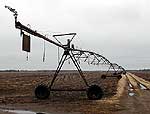By Dan Gunderson
Minnesota Public Radio
May 6, 2002
Managing Minnesota rivers is a complex task. The Straight River near Park Rapids is a case in point. The small spring-fed stream is a rare northern Minnesota trout fishery. It's also an area where crops are heavily irrigated. Natural resource managers find themselves walking a fine line- protecting the fish without harming the farmers.
| |
|
|
|
|||
Straight Creek begins as a trickle flowing out of the sandy soil of eastern Becker County. A few miles away, the stream feeds Straight Lake, which in turn empties into the Straight River. Along the way, the river is fed by dozens of cold, clear springs. Trout need cold water to survive.
Where the stream starts to take form, if flows over a V-shaped metal dam which records the stream flow.
"I call this nothing but a swamp. That's what it is," says Bob Dewandeler, as he stands over the tiny stream he says is costing him a lot of time and money.
"It's flowing water. You can call that a river I guess, but there's no reason to bring your fishing equipment."
Bob Dewandeler farms about 900 acres. Most of it is irrigated. This sandy land produces little without irrigation.
About a mile away is a freshly-drilled well. Dewandeler hopes to use the well to irrigate beans this summer on a new piece of land. He's likely to get a permit from the Department of Natural Resources, but he's not happy.
The DNR made him pump water from the well for 72 hours. That test pumping will show if the well affects the Straight River. Dewandeler says the test cost him more than $2,000.
| |
|
|
|
||
Research shows irrigation wells can take water away from the small springs that feed the stream.
Dewandeler points to the new well and shakes his head in disgust.
"I just told 'em right from the start, 'We're just spending money that shouldn't be spent - my money,'" Dewandeler says. "I'm just a little guy. I'm not budgeted for this extra stuff either. I waited three years after buying the land to feel I could borrow the money to put in the irrigator. Then you add these expenses on it."
Bob Dewandeler is a small farmer - a small player in the management of the Straight River. The big player here is the R.D. Offutt Co., growing thousands of acres of irrigated potatoes in the Straight River basin.
Offutt is by far the largest water consumer, and the company continues to expand. Offut also runs a french-fry plant near the Straight River which uses millions of gallons of water. Offut company officials declined to be interviewed for this story.
Scientists agree pumping a lot of water from wells can take water away from springs that feed the Straight River. But the interaction between groundwater and stream is complex, and not well understood.
| |
|
|
|
||
DNR Hydrologist Bob Merritt has been trying to understand this river basin for more than 20 years.
"Certainly, we're a lot more proactive now than we were 10 or 15 years ago," Merrit says. "We're getting in front of it, and I feel good about that."
Merrit says more research is needed. But research is expensive and time-consuming. He says the DNR is short of money and people. He's fairly confident the Straight River is not in immediate danger. But he worries about increased irrigation, and what may happen in a drought.
"None of us wants to be the one who - sometime in the future - has to say, 'We screwed up.' We want to do it right. We also realize we need the economy up there. We need to do better in making sure both sides are taken care of," Merrit says.
"A good place for a fish to sit is right there, where the water comes around," says Ron Miller, as he wades through thigh-deep water on a recent Saturday morning. It's trout season opener, and Miller is a self-described fly fishing fanatic.
Miller, a pediatrician in Fargo, has been casting for trout in the Straight River the past 25 years. He knows every bend and riffle.
| |
|
|
|
||
"It's a wild, unique place. This morning already we've heard ducks, geese, coyotes, ruffed grouse, deer - now we're hearing some birds come."
Ron Miller is also a member of Trout Unlimited, one of the groups that sued the state a decade ago, seeking greater protection for the Straight River.
He says some good things have happened since then. Farmers' irrigation permits are more closely scrutinized. A study provided the DNR better information about the health of the stream and the fish that live in it.
But Miller is frustrated that there is not yet a management plan in place to protect the river.
"Can the DNR get it together and protect this river? Or are they going to go - hydrologists here and fisheries there -and just sort of never really get it protected?" Miller asks. "Will the intense agricultural pressures force them to capitulate in a political manner to those interests?"
In reality, it's not quite that simple. The DNR wants to develop a management plan for the Straight River. It's not clear what the scope of the plan would be. But before the agency can call for changes in farming practices or restrict development, they need proof that irrigation damages the river.
| |
|
|
|
||
Area Fisheries Manager Doug Kingsley says that makes his job challenging. There's some anecdotal evidence the Straight River has deteriorated over the years. It once supported brook trout, but warmer water wiped them out, leaving the less sensitive brown trout. Kingsley says with rising water temperature, even the brown trout are not safe.
"We are getting very close, I think, to the level these trout can sustain. We get periods where it's getting up into the 70s. And that's getting pretty close to the lethal limits," says Kingsley.
But what's causing warmer water in the river? Is it because irrigation wells are sucking dry some of those cold clear springs? Kingsley says maybe. But state law protects farm irrigation. Once a permit is granted, it's very difficult to shut down the well.
"The difficulty would be - if we saw effects on the fishery, we would have to be able to somehow prove it was because of the water withdrawals," says Kingsley. "That would be pretty difficult, maybe impossible to do, and I'm not sure we could prove that."
Kingsley is hopeful the DNR will start work on a managment plan sometime in the next several years.
Meanwhile, a half dozen new irrigation wells will start pumping this summer.





